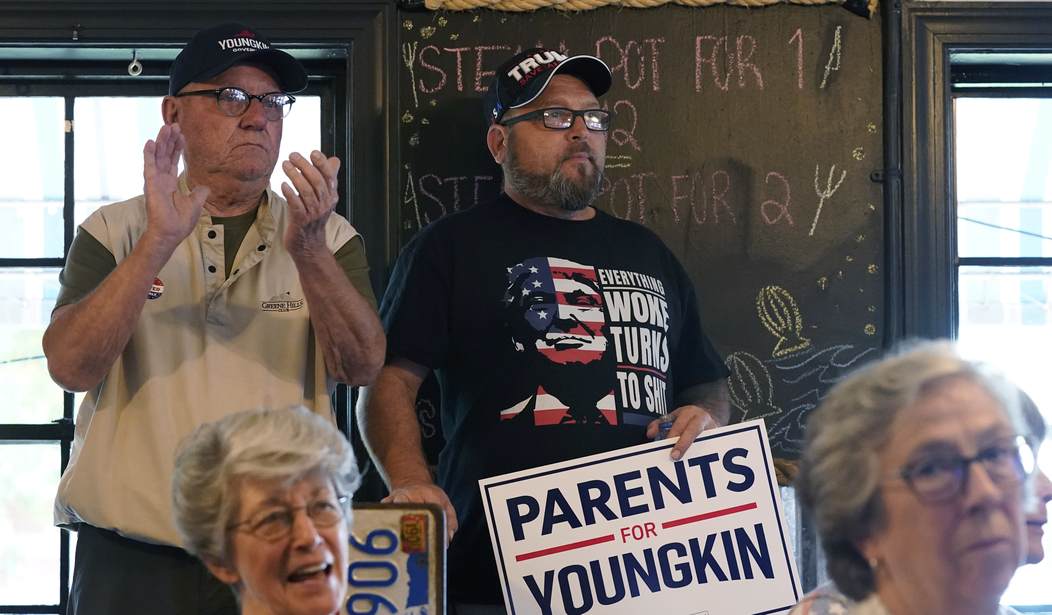But they’re trying, they’re trying! The New York Times issued its own warning to the Democratic Party and progressives, even before Politico’s twin cris des coeurs this morning, about the glum prospects for 2022’s midterms. And while their headline focuses on “rural America,” their real problem is in the suburbs, as the NYT makes clear:
In the jigsaw puzzle that is electoral politics, Democrats have often focused their energy on swingy suburbs and voter-rich cities, content to mostly ignore many white, rural communities that lean conservative. The belief was, in part, that the party had already bottomed out there, especially during the Trump era, when Republicans had run up the numbers of white voters in rural areas to dizzying new heights.
Virginia, however, is proof: It can get worse. …
Mr. Youngkin not only won less populated areas by record margins — he was outpacing former President Donald J. Trump’s 2020 showing in even the reddest counties, including by six percentage points in Bath County — but he also successfully rolled back Democratic gains in the bedroom communities outside Washington and Richmond, where many college-educated white voters had rejected Republicanism under Mr. Trump.
The twin results raise a foreboding possibility for Democrats: that the party had simply leased the suburbs in the Trump era, while Republicans may have bought and now own even more of rural America.
The suburbs will remain competitive for multiple reasons, although none of these will likely apply in time for the 2022 midterms. First, suburban voters are the most responsive to economic data, which means that the party in power will always struggle to hold them in times of economic uncertainty. Second, suburbs come under population pressure of expansion from more-liberal urban centers, so Democrats benefit from that constant influx, even while Republicans get closer to them culturally. The losses in Virginia, but especially in New Jersey, show that the combination of economics and cultural sympathy can and will cause flips back to the GOP, especially in periods where Democrats have full control of Washington and seem to be doing nothing with it.
Voters in rural counties, however, are aligning more and more with the GOP on a cultural basis. That reminds the NYT of one of the Democrats’ key constituencies, and presents a formidable question to Democrats:
Republicans have never had a demographic stronghold as reliable as Black voters have been for Democrats, a group that delivers as many as nine out of 10 votes for the party. But some Democratic leaders are now sounding the alarm: What if rural, white voters — of which there are many — start voting that reliably Republican? …
The rural share of the vote in America has been steadily shrinking, but remains sizable enough to be politically potent. National exit polling in 2020 estimated that one in five voters lived in rural or small-town America. The Democratic data firm TargetSmart, which categorized voters based on population density, labeled 30 percent of the electorate as rural.
But while some Democratic politicians now recognize the scope of their rural problem, the words of voters in Bath County expose the difficulty in finding solutions. In interviews with a dozen white, rural voters who backed Mr. Youngkin, policy was less important than grievance and their own identity politics.
That does sound familiar, doesn’t it? It’s the same basis of affinity that Democrats built with black voters, and to a lesser extent urban voters in general. It used to work with Hispanic voters too, but that demographic has slowly begun slipping away from Democrats, even during Donald Trump’s elections and despite his intemperate rhetoric on illegal immigrants. Cultural affinity binds voters more closely than economics, and Republicans have succeeded in taking that page out of the Democratic playbook.
That, however, also has its limits — as Democrats are currently discovering in the dead end of “wokeness.” If you routinely win 90% of a demographic, it’s great — but it doesn’t guarantee success, and it gives the other party a handy target. It’s one thing to build an affinity with an important demographic, but it’s quite another when a party defines itself utterly by that affinity. The pursuit of radical policies like critical race theory-informed curricula in primary education eventually backfires, and suddenly the non-affinitized demographics voters get repulsed.
In any case, Democrats can win with only a minority of rural voters as long as they win the suburbs. Last week’s elections showed that the red wave is primarily coming from the suburbs and the exurbs, and that the Democrats’ foolish double-down on calling voters racists will keep fueling it in precisely those precincts. Until Democrats cut themselves loose from radical Academia, they will continue to lose the suburbs, especially under the incompetent leadership of Joe Biden. And when Republicans take charge, they’d better be mindful of the same lessons.







Join the conversation as a VIP Member